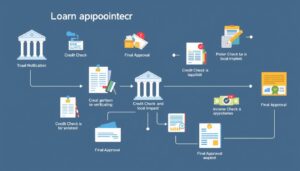Ever wondered why some people get loans fast while others wait forever? Knowing how to get quick loan approval is key. It helps you get the money you need, whether for personal, business, or mortgage loans. This section will share tips to boost your chances of getting loans approved fast.
It’s all about understanding loan strategies, what lenders want, and personal finance basics. With the right knowledge, getting a loan can be much easier. Keep reading for valuable insights to help you find the best financing options. To help you, read our article with 7 tips for applying for a loan.
Understanding the Basics of Loans
A loan is money borrowed with the promise to pay it back with extra interest. It helps many people, businesses, and groups. Knowing the different types of loans helps borrowers make smart choices. These include personal loans, mortgages, auto loans, and business loans, each for a specific need.
It’s important to understand loan terms before borrowing. The amount borrowed is called the principal, and the cost of borrowing is the interest rate. The time to pay back the loan is the term, which changes based on the loan type. For example, personal loans have shorter terms than mortgages, which last for years.
Debt consolidation is another common concept. It combines several debts into one loan. This can make payments easier and might lower interest rates. Knowing these basics helps people choose the best loans for their situation.
Importance of Credit Scores in Loan Approval
Credit scores are key in getting loans approved. Lenders look at these scores to see if they can trust the borrower. Knowing how credit scores work can help you get the funds you need.
Calculating credit scores involves a few important parts. Payment history is a big part, showing if you pay on time. How much credit you use also matters. Plus, how long you’ve had credit and the types of credit you have add to your score. All these parts show how reliable you are with money.
If you want a loan, improving your credit score is crucial. Paying bills on time and lowering debt can help a lot. Also, checking your credit report for mistakes can make a big difference. By taking care of these things, you can get better loan offers.
Preparing Your Financial Documents
When you’re looking for a loan, having the right financial documents is key. Lenders need to see your financial stability. They look at tax returns, pay stubs, bank statements, and ID.
These loan application documents help lenders understand your income and assets. This is how they decide if you’re a good risk.
To make the application smoother, it’s important to organize finances well. Keep all your documents in one spot and make sure they’re up to date. A neat folder or digital folder helps you find things fast and avoids missing important papers.
By focusing on detail when preparing these documents, you can boost your chances of getting a loan. Lenders will see you’re serious and well-prepared.
Choosing the Right Lender
Choosing a lender is key when you need a loan. There are many types, like banks, credit unions, and online lenders. Each has its own benefits and suits different needs.
Banks are good for big loans and offer a wide range of services. Credit unions might have lower rates for their members. Online lenders are great for quick, easy applications.
Recommended articles:
- Upgrade: The Best Choice for Consolidating Debt with Low Interest
- Credible: A Quick Comparison to Find Your Ideal Loan
Before picking a lender, ask them important questions. Find out about loan terms, rates, and fees. Knowing how they treat customers can also matter a lot.
By asking the right questions, you can pick the best lender for you. This ensures your loan meets your financial goals.
Loan Application Process Explained
The loan application process has several key steps. It helps applicants from the beginning to the end. First, potential borrowers need to check their finances and see how much they can borrow. This step is important for the next parts of the application.
Then, there’s pre-qualification. It gives an idea of the loan amount you might get. This helps narrow down lenders and loan choices. After pre-qualification, you fill out the official loan application. It’s important to be thorough here to avoid mistakes.
After submitting the application, lenders review your financial documents and credit score. This is the waiting period for their decision. If approved, you’ll get a list of conditions to meet for final approval. Meeting these conditions quickly is key to success.
Knowing Your Loan Limits
Loan limits show the highest amount you can borrow from a lender. Many things affect these limits, like your income, credit score, and how much debt you have. It’s key to understand these to get a loan.
Before borrowing, check your finances. Look at your income and debts. This helps figure out how much you can borrow. It’s important to make sure you can pay back the loan each month.
Using budgeting can help you not borrow too much. Make a budget with your current and future money needs. This way, you can choose the right loan amount. Knowing your loan limits helps you make smart borrowing choices.
Interest Rates and Loan Terms
Understanding interest rates is key when picking between fixed and variable rate loans. Fixed rate loans keep the interest rate the same, making it easier to budget. This means you can count on the same monthly payment every month, which helps with long-term planning.
Variable rate loans start with lower rates, which can lower your first payments. But, as rates change, so do your payments. This could save you money if rates go down. Yet, if rates go up, your payments could increase, which might be risky.
The length of your loan also matters a lot. Short-term loans have higher monthly payments but save you money on interest because you pay off the loan faster. Long-term loans have lower payments, giving you more cash flow right away. But, they cost more in interest over time. Thinking about how interest rates and loan terms work together helps you make smarter choices when buying something big.
Using Online Tools for Loan Comparison
Many borrowers feel overwhelmed by the many loan offers today. Loan comparison tools make this easier. They let people compare different loan terms from various lenders quickly.
When using these tools, it’s key to enter the right loan amount and personal financial info. This makes sure the comparisons are accurate and show the best options. By looking at loan offers side by side, borrowers can find the best interest rates and terms. Before applying, use tools like this loan simulator to calculate the costs and make sure the amounts are in line with your budget.
These tools do more than just compare interest rates. They also show extra fees for each loan. This helps borrowers make a smart choice. Looking at all options carefully can save a lot of money over time.
Understanding Fees Associated with Loans
When you’re looking at a loan, knowing about loan fees is key. Fees like origination, application, and closing costs can add up. Understanding these can help you prepare and avoid surprises.
Talking about common loan fees with lenders is smart. It’s important to ask about fees and if they can be changed. Some lenders might be able to lower or remove fees, saving you money.
Looking for lenders with clear fee structures helps too. By comparing different lenders, you can find one that fits your budget. This way, you can get a loan that’s right for you without extra costs.





